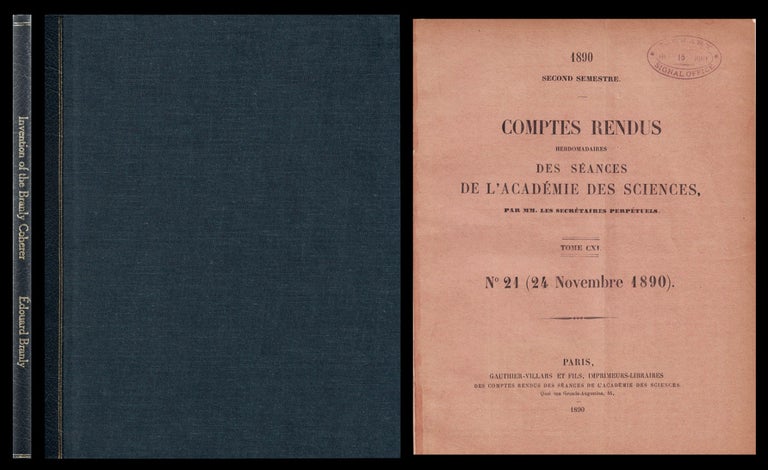Variations de conductibilite sous diverses influences electriques in Comptes Rendus de l’Academie des Sciences 111, pp. 785-787, 1890
Paris: Gauthier-Villars, 1890. 1st Edition. ORIGINAL PAPER WRAPS, FIRST EDITION, OF THE DISCOVERY OF THE BRANLY EFFECT & THE INVENTION OF THE ‘COHERER’, THE FIRST WIDELY USED SIGNAL DETECTOR FOR RADIO COMMUNICATION. The paper offered here is housed in a custom pamphlet case. Note that we offer Bose's "iron-mercury-iron coherer paper separately.
Though one of the first pioneers in the field of wireless transmission, Branly always denied being one of the fathers of radio communication. Perhaps “more accurately, Branly’s discovery of a physical effect [the Branly effect] gave him the opportunity to devise an efficient wave sensor (the coherer) that permitted the invention of radio” (Dilhac, “Edouard Branly, the Coherer, and the Branly Effect,” in IEEE Communications Magazine, September 2009, 20).
“In June 1890… [Branly was] concentrating on the influence of irradiation on the electrical conductivity of various substances submitted to the light from the spark. Branly had devised a first circuit to create sparks suing the Wimshurt machine, and then a second very simple circuit: a Daniell battery, a galvanometer, and a metallic disk all wired together in series. The disk was initially electrically charged. The two circuits were initially close to each other, so the light from the spark illuminated the disk. Following the spark, in some cases a dramatic increase in disk conductivity could be detected by the galvanometer. In November 1890, he replaced the disk with a tube filled with oxidized Zn particles. Just after the spark, it was again found that the conductivity of the tube was increased by several orders of magnitude.
“[Branly] then inserted various obstacles between the spark and the tube in order to evaluate the properties of the propagation of the invisible part of the light between spark and tube. At one point he inserted a piece of cardboard and noticed that the effect persisted. He then put the circuit made of the battery, galvanometer, and tube in another room, 20 meters away, separated by thick walls and a courtyard from the Wimshurt spark-emitting circuit: the effect persisted while neither the light from the spark nor its sound could be seen or heard by Branly sitting by the tube while his aide Rudolphe Gendron was operating the electrostatic machine. A small shock was found to restore the initial conductivity value, while a new spark allowed the phenomenon to be repeated. His paper on this work was published in French on 24 November 1890 [and is the paper offered].
“Branly called the detecting device (the tube filled in with metallic particles) a radioconductor: this is likely to have been the first use of the prefix radio in the text of wireless communicatiosn. For Branly, the term radio referred to the electric radiation from the spark” (ibid). Item #1034
CONDITION & DETAILS: Paris: Gauthier-Villars. 4 to. [10.5 x 8 inches]. Original wraps. Complete. Professionally repaired at the spine; tiny closed tear at the outer edge of the front wrap; light library stamp (see photos). Pristine blue cloth custom case, gilt-ruled on the boards; gilt-lettered at the spine. Bright and very clean inside and out. Very good +.
Price: $775.00

